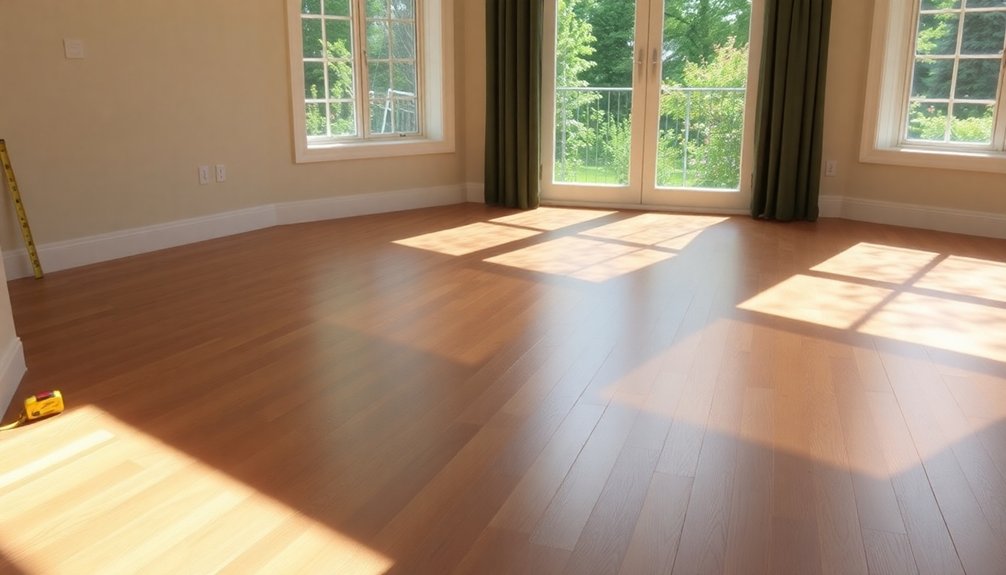Your floor should slope no more than ½ to 1 inch for every 20 feet to maintain safety and structural integrity. If the slope exceeds 2 inches, it may indicate serious foundation issues that could lead to costly repairs. Budget for potential foundation assessments, ranging from $300 to $1,000, and additional costs for repairs that could amount to $12,000 or more. Understanding these factors can help you make informed decisions about your home’s condition and value, revealing more insights on maintenance and repair needs.
Understanding Floor Slope Measurements
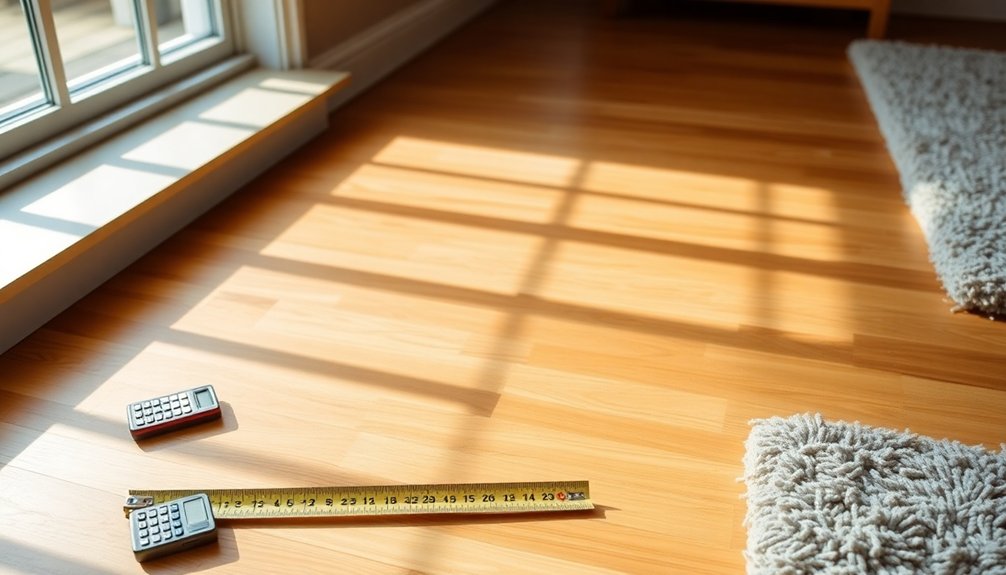
Have you ever wondered how to measure floor slope accurately? Understanding floor slopes is essential for maintaining your home’s structural integrity.
Start by using a level or a long straightedge to determine the height difference across a 20-foot span. Ideally, acceptable slopes should be between ½ inch to 1 inch. If you notice a slope greater than 2 inches over that distance, it could signal foundation problems that need immediate attention.
Remember, intentional slopes may exist for drainage, especially in basements or utility areas. However, consistent slopes differ from sagging floors, which indicate varied underlying issues. Additionally, accurate categorization of expenses related to home maintenance can help in budgeting and forecasting for necessary repairs and improvements.
Acceptable Slope Levels for Residential Homes
When it comes to maintaining a safe and comfortable home, understanding acceptable slope levels for residential floors is essential. Generally, a slope of ½ inch to 1 inch for every 20 feet is ideal. If you notice slopes exceeding 2 inches, it’s a red flag for potential structural issues that might require immediate foundation repairs. While some builders intentionally slope floors for drainage, any deviations from the original design could indicate deeper problems. Although building codes don’t specify maximum allowable slopes for interior floors, sticking to acceptable slope measurements helps maintain your property’s value and safety. Regular inspections and assessments are vital, especially in older homes, to catch and resolve structural issues before they turn into costly repairs. Additionally, adhering to budgeting principles can help manage the costs associated with necessary repairs or renovations.
Common Causes of Sloping Floors
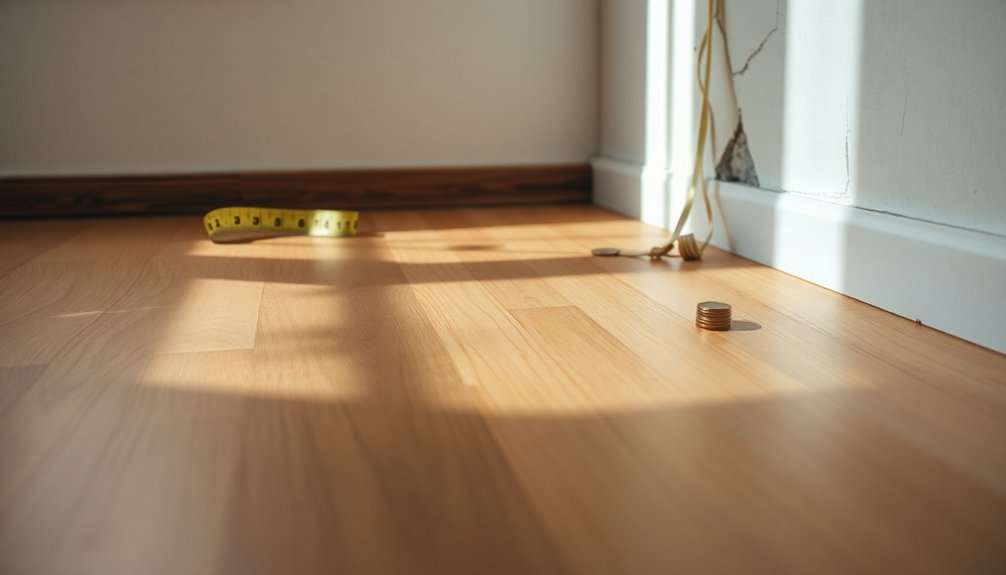
Sloping floors can often point to serious underlying issues in your home, like foundation problems or moisture that leads to wood rot.
You might notice that as your house settles, support structures shift, causing uneven surfaces.
Understanding these common causes can help you address the issue before it worsens. Regular reviews of savings and investment performance support informed decision-making, which can be crucial when considering home repairs.
Foundation Issues
Foundation issues can lead to significant problems in your home, often manifesting as sloping floors. One common cause is differential settling, which can result from soil erosion, excessive moisture, or inadequate foundation design.
When moisture seeps in, it can cause wooden floor joists to rot, contributing to sagging floors and serious structural problems. Additionally, cracks in your foundation signal larger issues that could lead to uneven surfaces and sloping floors.
If your home is older, normal settling can exacerbate these problems if maintenance isn’t prioritized. To protect your investment, make regular inspections of your foundation and the surrounding soil conditions.
Identifying and addressing these issues early can save you from costly repairs down the line.
Moisture and Rot
Moisture can wreak havoc on your home’s structure, especially when it seeps into wooden floor joists and beams. Excessive moisture leads to rot, creating a vital structural problem that can result in sloping floors.
Damp crawl spaces or basements often accelerate decay, causing your floorboards to sag or bow over time. Foundation leaks and inadequate drainage systems contribute to moisture buildup, increasing the risk of moisture damage.
To combat these issues, regular inspections for water damage and moisture levels around foundation walls are essential. Additionally, maintaining proper ventilation and using moisture barriers in crawl spaces can greatly reduce the risk of wood rot, helping to keep your floors level and your home structurally sound.
Settling Support Structures
When your home’s structure is compromised by moisture issues, it can lead to a cascade of problems, including settling support structures that contribute to sloping floors.
Uneven settling of the soil beneath your foundation can cause differential settlement, resulting in noticeable slopes and potential structural damage. Inadequate support from aging or undersized floor joists may also lead to sagging, worsening the uneven floors you may notice.
Additionally, moisture can rot wooden beams and floor joists, compromising their integrity over time.
Regular inspections of your crawl space and basement are essential for catching early signs of settling issues, like cracks in walls or gaps between floors and baseboards, before they escalate into major repairs.
Signs Indicating Structural Issues
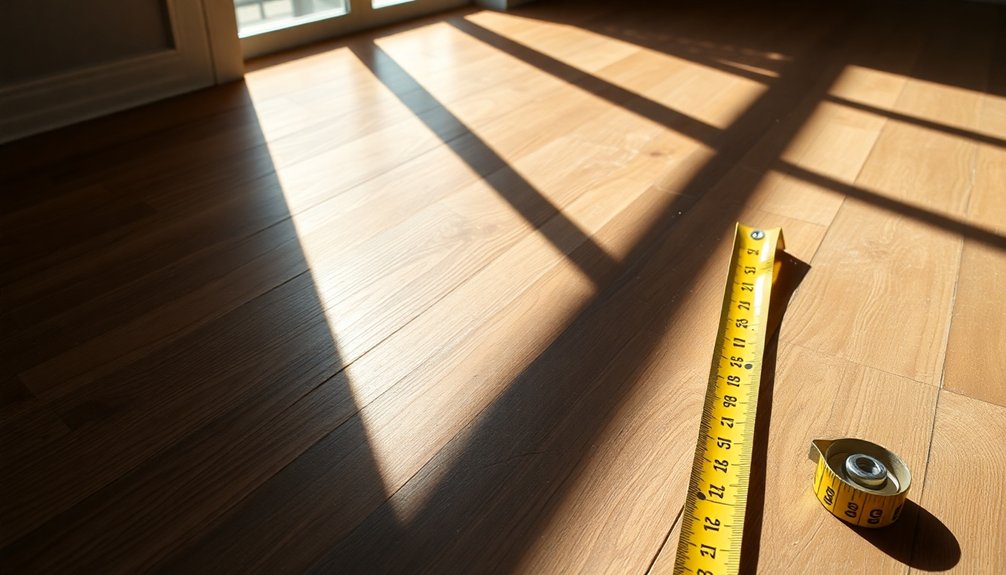
If you notice cracked foundations or uneven wall surfaces in your home, it’s essential to take action. These signs often point to underlying structural issues that could worsen over time. Keeping an eye out for these indicators can help you address potential problems before they escalate. Using expense management apps can help you keep track of any costs associated with repairs or maintenance.
Cracked Foundations Observed
Cracked foundations can be a homeowner’s nightmare, signaling potential structural issues that shouldn’t be ignored. These cracks often arise from common causes like differential settling or excessive moisture affecting your home’s foundation.
If you notice cracks wider than 1/8 inch, it’s essential to seek professional assessment immediately, as these may indicate serious problems. Horizontal cracks in basement walls suggest hydrostatic pressure from accumulated water outside, while vertical cracks are typically linked to settling issues.
Additionally, cracks in interior walls and ceilings, especially above door frames, can signal shifting foundations. Regular inspections and monitoring of these cracks can help you catch structural issues early, potentially saving you from expensive repairs in the future.
Stay proactive for your home’s safety!
Uneven Wall Surfaces
Uneven wall surfaces can be a clear warning sign that your home may be facing structural issues. Look for cracks or bulges, as these often indicate problems like settling foundations or deteriorating materials.
Diagonal cracks around windows and doors suggest potential shifting, while hairline cracks might hint at minor settling. However, larger, newer cracks signal serious issues that need immediate attention.
If your walls bow or lean inward, it could mean excessive moisture or weak supports, risking further damage. Regular inspections are essential for catching these signs early, especially if you’ve noticed a sloping floor.
Addressing issues promptly can save you from costly foundation repair and prevent water damage, ensuring your home remains safe and sound.
Estimated Repair Costs for Sloping Floors
When you notice sloping floors in your home, it’s crucial to understand the potential repair costs involved. The estimated repair costs can range considerably, from $1,000 to $12,000, depending on the severity and underlying issues.
Understanding the potential repair costs of sloping floors is essential, ranging from $1,000 to $12,000 based on severity.
Foundation repairs, often necessary for sloping floors, typically average between $4,000 and $10,000. If you need to replace damaged floor joists or subflooring, expect to spend an additional $2,000 to $5,000.
Don’t forget about assessment fees, which can run from $300 to $1,000. If moisture problems contribute to the slope, waterproofing solutions might add another $1,500 to $3,000. Additionally, it’s important to consider the importance of financial literacy when budgeting for these repairs to ensure you are making informed decisions about your finances.
To guarantee accuracy in addressing these issues, it’s wise to hire an expert for a thorough evaluation.
Benefits of Leveling Floors
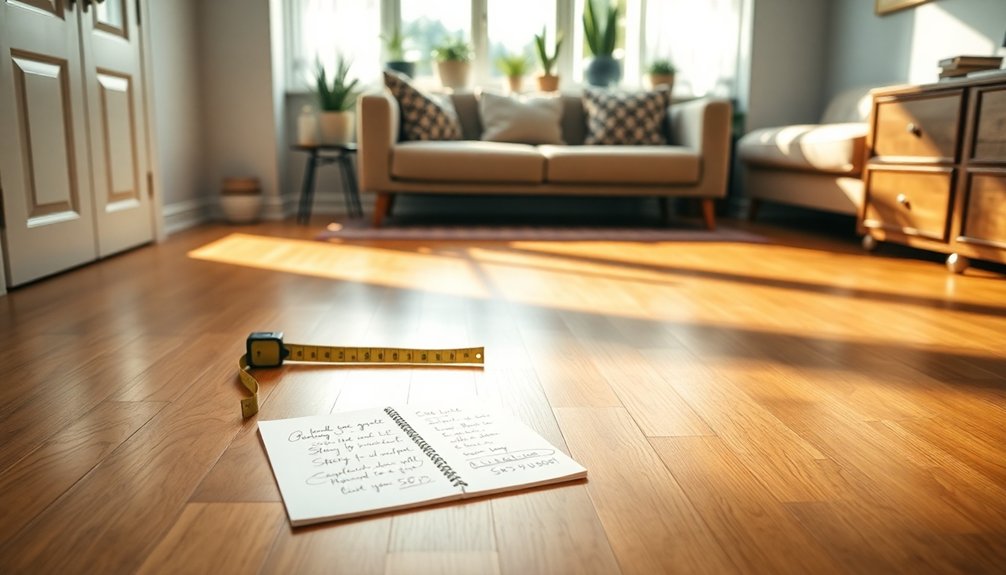
Addressing sloping floors not only tackles immediate concerns but also brings a host of benefits that can enhance your home’s overall appeal and functionality.
One of the primary benefits of leveling floors is improved structural integrity, which keeps you and your family safe. A level floor also boosts your home’s value, making it more attractive to buyers and preventing low offers tied to perceived structural issues.
Aesthetically, it creates a visually pleasing environment, enhancing your comfort. Additionally, leveling improves functionality, allowing for easier furniture placement and better accessibility. Furthermore, ensuring financial clarity during home renovations can help you allocate resources effectively.
Professional Assessment and Solutions
If you notice sloping floors in your home, getting a professional assessment is essential to understanding the underlying issues.
A thorough inspection by qualified home inspectors or structural engineers will help determine the cause, typically costing between $200 and $500. They’ll provide insights into acceptable slope measurements, generally between ½ inch to 1 inch for every 20 feet.
If your floors exceed this, solutions may include hiring specialized contractors for repairs, ranging from a few hundred dollars for minor fixes to several thousand for major foundation work. Regular assessments are vital to monitor floor slope changes, as early detection can prevent costly repairs and enhance your home’s safety and value. Additionally, consider conducting periodic audits to ensure that any necessary repairs are made promptly and efficiently.
Don’t wait—address those sloping floors now!
Long-Term Maintenance Considerations
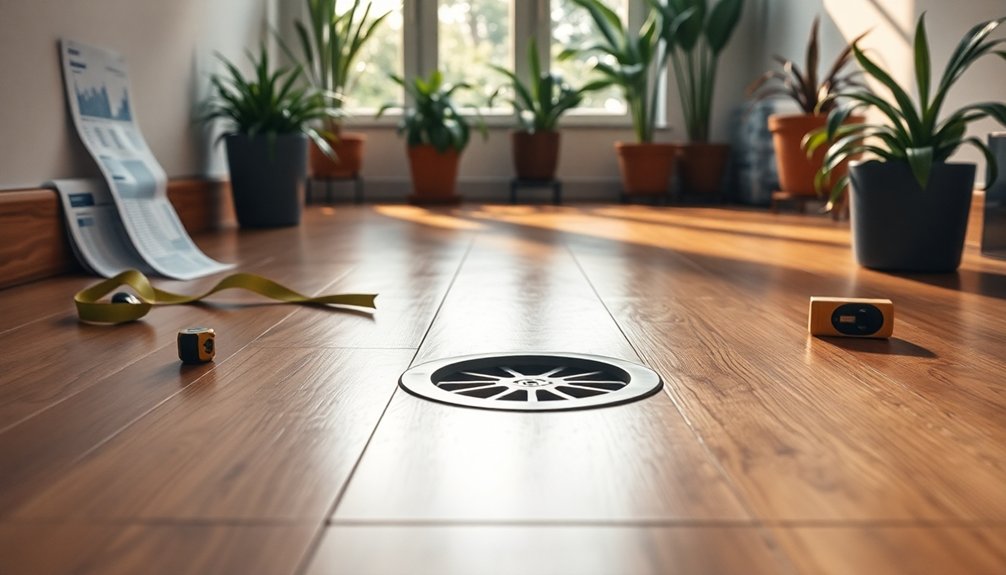
After getting a professional assessment of your sloping floors, it’s important to focus on long-term maintenance to prevent future issues.
Regular inspections of your flooring and foundation can help spot early signs of slope problems, allowing for timely repairs that can save you money down the line.
One key aspect of long-term maintenance considerations is maintaining proper drainage around your home. Excess moisture is a common cause of sloping floors, so investing in waterproofing solutions for basements and crawl spaces is wise.
Additionally, promptly addressing any damage to floor joists can extend the lifespan of your flooring systems.
Budgeting for regular maintenance and potential repairs, like underpinning or floor leveling, will help you avoid significant financial burdens in the future. Moreover, budget management tools can assist you in planning for these ongoing expenses effectively.
Impact of Floor Slope on Property Value
While a slight slope in your floor might seem like a minor issue, it can actually have a significant impact on your property’s value. A floor slope exceeding 1 inch for every 20 feet can deter potential buyers, as it raises concerns about structural issues.
Homes with noticeable slopes often see offers reduced by 10% to 20%, affecting your bottom line. Real estate appraisers and insurance companies factor in floor slopes when evaluating value, and unacceptable slopes may disqualify your home from certain loans.
Fixing these issues can yield an impressive ROI of up to 85%, making it worthwhile to invest in repairs. Addressing sloping floors before listing can enhance your home’s appeal and ultimately increase its market value. Additionally, timely payment reminders can help you manage expenses effectively while considering necessary repairs to your home.
Conclusion
So, unless you’re planning on installing a mini ski slope in your living room, it’s best to keep your floors level. After all, no one wants their couch to double as a bobsled. By addressing any sloping issues, you not only enhance your home’s safety and comfort but also preserve its value. Remember, a straight floor isn’t just about aesthetics; it’s about ensuring your house doesn’t turn into a funhouse where gravity takes a vacation!

